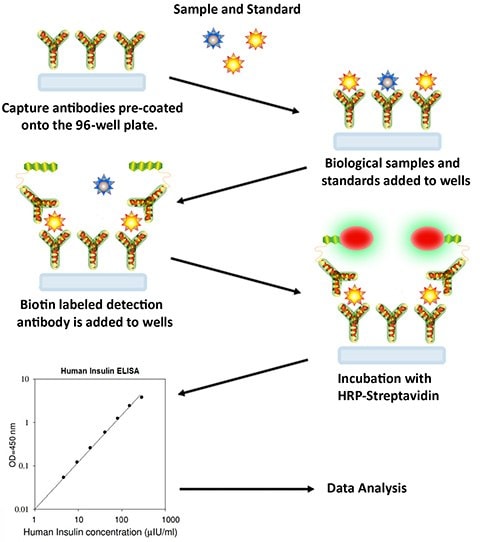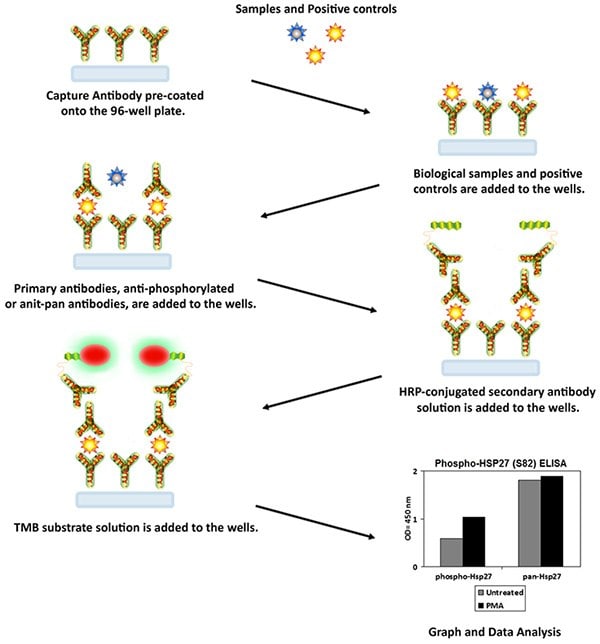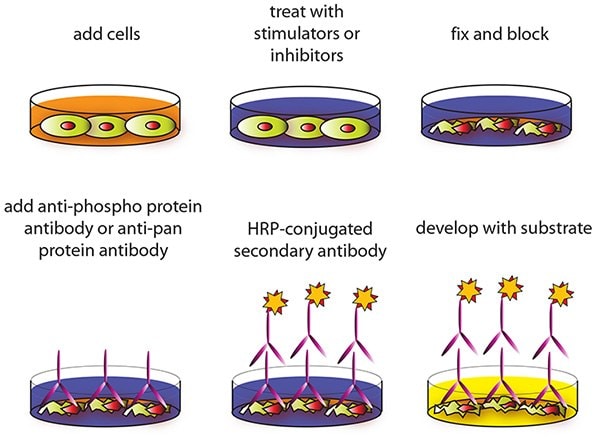ELISA实验方法
这些实验方法仅用作一般参考。具体ELISA试剂盒详细实验方案请见相应产品详情页面。进入我们的ELISA中心页面搜索所有ELISA方案。
夹心法检测过程
- 在使用前让所有试剂和样品恢复至室温(18 - 25 °C)。建议为所有的标准品和样品设置至少双重复。
- 向相应的孔中添加100 μL的每种标准品和样品。盖上孔并在室温孵育2.5小时或4 °C过夜,并轻轻摇晃。
- 弃溶液并用1X 洗涤溶液洗涤4次。通过使用多通道移液器或自动洗板仪向每孔中填充洗涤缓冲液(300 µL)以进行洗涤。在每一步都将液体完全去除对于优秀的性能至关重要。在完成最后一次洗涤后,通过吸取或倾倒而将残留的洗涤缓冲液进行去除。将平板倒置,并用干净的纸巾将其吸干。
- 向每孔中添加100 μL制备好的1x 检测抗体。盖上孔并在室温孵育1小时,并轻轻摇晃。
- 弃溶液。重复第3步的洗涤步骤。
- 向每孔中添加100 μL制备好的链霉亲和素溶液。盖上孔并在室温孵育45分钟,并轻轻摇晃。
- 弃溶液。重复第3步的洗涤步骤。
- 向每孔中添加100 μL TMB One-Step底物试剂(H项)。盖上孔并在室温避光孵育30分钟,并轻轻摇晃。
- 向每孔中添加50 μL 终止液(I项)。立即测量450 nm处的吸光度。

磷酸化检测过程
- 在使用前让所有试剂恢复至室温(18 - 25 °C)。建议为所有的样品或阳性对照设置至少双重复。
- 向相应的孔中添加100 μL的每种样品或阳性对照。用板支架盖上孔并在室温孵育2.5小时或4 °C过夜,并摇晃。
- 弃溶液并用1x 洗涤溶液洗涤4次。通过使用多通道移液器或自动洗板仪向每孔中填充洗涤缓冲液(300 µL)以进行洗涤。在每一步都将液体完全去除对于优秀的性能至关重要。在完成最后一次洗涤后,通过吸取而将残留的洗涤缓冲液进行去除。将平板倒置,并用干净的纸巾将其吸干。
- 向每孔中添加100 μL制备好的1X生物素化抗磷酸酪氨酸抗体。室温孵育1小时,并摇晃。
- 弃溶液。重复第3步的洗涤步骤。
- 向每孔中添加100 μL制备好的X HRP-链霉亲和素溶液(见试剂制备第6步)。室温孵育45分钟,并摇晃。
- 弃溶液。重复第3步的洗涤步骤。
- 向每孔中添加100 μL TMB One-Step底物试剂(H项)。室温避光孵育30分钟,并摇晃。
- 向每孔中添加50 μL 终止液(I项)。立即测量450 nm处的吸光度。

EIA检测过程
- 在试剂制备过程中将试剂置于冰上。建议为所有的标准品和样品设置至少双重复。
- 向每孔中添加100 μL 抗-“靶标”抗体。室温孵育1.5小时,并轻轻摇晃(1-2圈/秒)。您还可以在4 °C孵育过夜。
- 弃溶液并用1x 洗涤缓冲液(每孔200-300 μl)洗涤4次,可用多通道移液器或自动化的洗板仪完成洗涤。在每一步都将液体完全去除对于优秀的检测性能至关重要。在完成最后一次洗涤后,通过吸取或倾倒而将残留的洗涤缓冲液进行去除。将平板倒置,并用干净的纸巾将其吸干。
- 向相应的孔中添加100 μL的每种标准品、阳性对照和样品。确保包含了一个空白孔(仅含检测稀释液)。室温孵育2.5小时,并轻轻摇晃(1-2圈/秒),或4 °C过夜。
- 弃溶液并按照第3步洗涤4次。
- 向每孔中添加100 μL制备好的HRP-链霉亲和素溶液。室温孵育45分钟,并轻轻摇晃。建议孵育时间不少于45分钟。
- 弃溶液并按照第3步洗涤4次。
- 向每孔中添加100 μL TMB One-Step底物试剂(H项)。室温避光孵育30分钟,并轻轻摇晃(1-2圈/秒)。
- 向每孔中添加50 μL 终止液(I项)。立即测量450 nm处的吸光度。

基于细胞的检测过程
注意:所有培养和洗涤步骤必须在轻轻摇动或旋转(~1 - 2 周期/秒)状态下进行。
- 设计您的实验。
可选:如果铺板的是HUVECs、HMEC-1或其他贴壁松散的细胞,可通过向每孔中加入100 μL 聚-L‐赖氨酸(推荐Sigma-Aldrich产品货号P4832)并按照操作说明而对未涂层的96孔微孔板(A项)进行涂层。预涂层的CellBIND® 微孔板或其他聚赖氨酸处理的组织培养板都可取代A项。 - 向已提供的未涂层96孔微孔板(A项)的每孔中铺板100 μL的10,000至30,000个细胞,并在含5% CO2的37 °C条件下孵育过夜。
注意:所用的最佳细胞数取决于细胞系和蛋白质磷酸化的相对量。细胞数量可多可少,但需要按实际进行确定。注意:在用抑制剂或激活剂处理前可将细胞饥饿~4-24小时(取决于细胞系)。 - 按照使用说明进行各种处理或使用各种抑制剂(如siRNA或化学品)或激活剂,并孵育至所需的时间点。
注意:建议在处理细胞之前将抑制剂或活化剂溶解在无血清的细胞培养基中(除非使用说明中另有说明)。 - 通过倒置微孔板并在水槽上方轻轻敲击微孔板的底部而将细胞培养基丢弃。
- 通过向每孔中移液200 μL制备好的1X 洗涤缓冲液(B项)而进行洗涤。弃去洗涤缓冲液(同第4步)并再洗涤2次,每次用新鲜的洗涤缓冲液总共进行3次洗涤。在完成最后的洗涤后,轻轻用纸巾吸干微孔板中多余或残留的缓冲液。
注意:为了避免细胞损失,不要直接对着细胞进行移液。相反,应让液体顺着细胞培养孔轻轻的流下。在弃去任何溶液时,也需要避免使用真空抽吸或用力敲击微孔板。 - 向每孔中添加100 μL 固定液(D项)并在室温孵育20分钟。
注意:固定液是用于透化细胞的。 - 重复第5步的洗涤步骤。
- 向每孔中添加200 μL制备好的1X 淬灭缓冲液(E项)并在室温孵育20分钟。
注意:淬灭缓冲液是将背景响应降至最低的。 - 用1X 洗涤缓冲液A洗涤4次。
- 向每孔中添加200 μL制备好的1X 封闭缓冲液(F项)并在37 °C孵育1小时。
- 用制备好的1X 洗涤缓冲液B(C项)洗涤3次。
注意:如果需要,可在此轮洗涤后将微孔板储存在‐80 °C数天。 - 向每个对应的孔中添加50 μL制备好的1X 一抗(G-1、G-2、G-3、H- 1、H-2或H-3项)并在室温孵育2小时。
- 用1X 洗涤缓冲液B洗涤4次。
- 向每孔中添加50 μL制备好的1X HRP偶联二抗(I-2项)并在室温孵育1小时。
- 重复第13步。
- 向每孔中添加100 μL TMB底物(J项)并在室温避光孵育30分钟。
- 向每孔中添加50 μL 终止液(K项)。立即测量450 nm处的吸光度。

产品
Loading
登录以继续。
如要继续阅读,请登录或创建帐户。
暂无帐户?